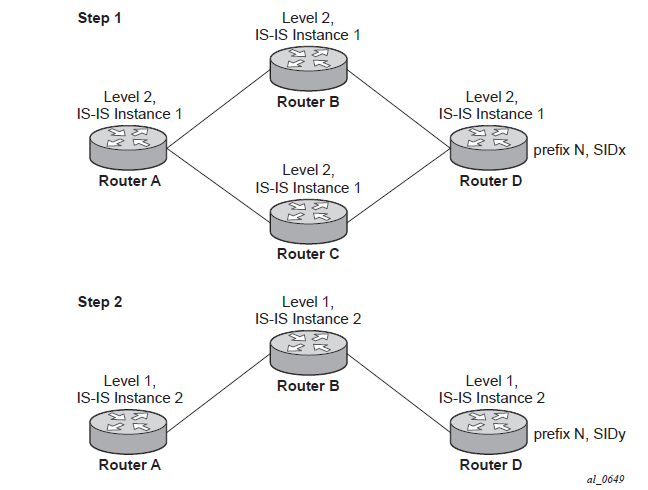The 7210 SAS supports assigning different prefix-SID indexes and labels to the same prefix in different IGP instances. While other routers that receive these prefix SIDs program a single route into the RTM, based on the winning instance ID as per RTM route type preference, the 7210 SAS adds two tunnels to this destination prefix in the TTM. This provides support for multiple topologies for the same destination prefix.
For example, in two different instances (L2, IS-IS instance 1 and L1, IS-IS instance 2 — see the following figure), Router D has the same prefix destination with different SIDs (SIDx and SIDy).

Assume the following route type preference in the RTM and tunnel type preference in the TTM are configured:
ROUTE_PREF_ISIS_L1_INTER (RTM) 15
ROUTE_PREF_ISIS_L2_INTER (RTM) 18
ROUTE_PREF_ISIS_TTM 11
The TTM tunnel type preference is not used by the SR module. It is put in the TTM and is used by other applications, such as VPRN auto-bind, to select a TTM tunnel.
Router A performs the following resolution within the single IS-IS instance 1, level 2. All metrics are the same and ECMP = 2.
For prefix N, the RTM entry is:
prefix N
nhop1 = B
nhop2 = C
preference 18
For prefix N, the SR tunnel TTM entry is:
tunnel-id 1: prefix N-SIDx
nhop1 = B
nhop2 = C
tunl-pref 11 (tunl-pref 10 for OSPF)
Add IS-IS instance 2 (level 1) in the same setup, but in routers A, B, and C only.
For prefix N, the TTM entry is:
prefix N
nhop1 = B
preference 15
RTM prefers the L1 route over the L2 route
For prefix N, there are two SR tunnel entries in the TTM:
SR entry for L2:
tunnel-id 1: prefix N-SIDx
nhop1 = B
nhop2= C
tunl-pref 11 (tunl-pref 10 for OSPF)
SR entry for L1:
tunnel-id 2: prefix N-SIDy